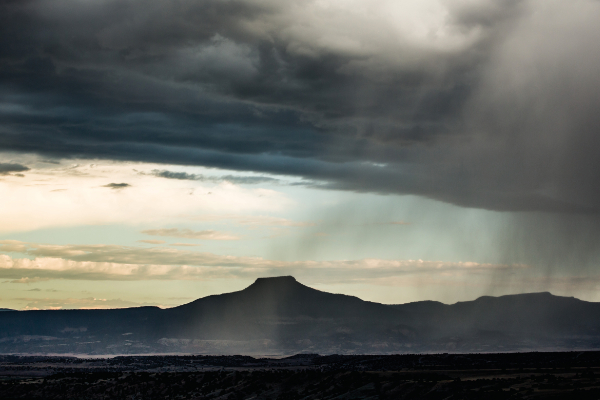She, The Mountain
By Santana Shorty
At a sleepover when I was seven, my friend said the mountain was a volcano that would erupt at any moment, cracking the dam and flooding Abiquiú. I stayed up most of that night panicking over my impending death. I prayed we would float down the valley like worn winter leaves on water. For years I watched the mountain, leery of her fragile flattop and percolating lava within. Many told me she wasn’t a volcano, but it took a long time before I was convinced we were safe. From her.
A few years ago, my sister sent me a video with the caption, “The influencers made it to Abiquiú.” In it, the person wears clear four-inch platform heels that reveal a set of encased dice. Where I come from, rolling the dice means something different. The influencer struts and poses on this path to my childhood home, the dice and stiletto points clattering on the humble paved road. I remember when the road was dirt.
I know the mountain’s every angle. When I look at her from the north, I am on the ribbon of highway approaching Youngsville, forty-five minutes from my dad’s house. From the northwest, her surreptitious pyramid top is visible, placing me at the cutting bend before the forest and elk begin. I’ve memorized every view of her, the center of this carousel that rotated me between houses, when my mother would drive me and my sister to the Coyote Forest Ranger Station for the weekend handover to our dad. By the time we got to his house, she was no longer visible.
It’s hard not to think of the famous painter when we see her. Though we’ve spent years taking back the narrative of Cerro Pedernal, the name of the woman the mountain made famous sits heavy on her horizon line. But we do see her as herself. Her steepled edging. Her supple corners. The mesa band of her brow. We see all that she stands for, against, in spite of. Consider all she’s witnessed: fawning artists, P’Oshu’Owingeh’s prime, the unfettered Chama River, selfie-taking tourists, the burning of Santa Rosa de Lima. The folly of believing you can own a mountain therein betrays the power and possession she has over you. She will endure after we die. She does not care where we sprinkle our ashes. She is not a volcano.
—
Santana Shorty earned her BA from Stanford University and her MFA from the Institute of American Indian Arts. Her work focuses on New Mexican landscape and culture. Currently, she is working on her first novel. She is a member of the Navajo Nation and lives in Santa Fe, New Mexico.

